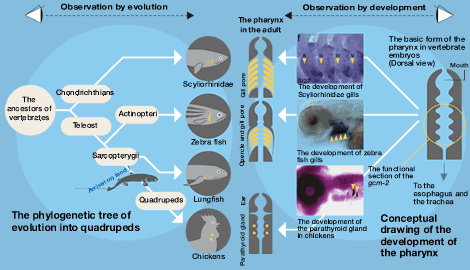When the pharynx is created in the neck and throat during the process of development, there is first a swelling on both sides of the alimentary canal. In quadrupeds, the gcm-2 gene operates here to create the parathyroid gland. We have recently discovered that in fish, which anatomically do not have a parathyroid gland, the same gcm-2 gene is used during the creation of the gills.
A study of the physiological function of the gills reveals they create the same hormones as the parathyroid gland and have a sensor that measures the concentration of calcium in the blood. The original function of the gills is to adjust the calcium concentration.
After we moved to land, the gills were no longer necessary as respiratory organs. We did not dispose of them, however, but made important use of them in the neck, converting them into the parathyroid glands required for life in the new environment. A look at the relationship between organ and function from the perspective of evolution and development clearly shows the circumstances of calcium adjustment. This is an interesting way to view the connections between living creatures and the changes they undergo. |
